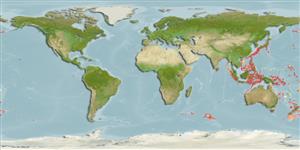>
Anguilliformes (Eels and morays) >
Muraenesocidae (Pike congers)
Etymology: Gavialiceps: Hindi, ghariyal = gavial, saurian of Ganges, 1825 + Greek, kephale = head (Ref. 45335); javanicus: Named after its type locality (Ref. 44791).
Environment: milieu / climate zone / depth range / distribution range
Écologie
marin bathydémersal; profondeur 560 - 600 m (Ref. 44791). Deep-water
Indo-West Pacific: Java, Indonesia and northwestern Australia.
Taille / Poids / Âge
Maturity: Lm ? range ? - ? cm
Max length : 89.0 cm TL mâle / non sexé; (Ref. 44791)
Description synthétique
Clés d'identification | Morphologie | Morphométrie
Dark brown, the back is darker than the belly. Peritoneum, gill and mouth cavities are dark and show through the skin. Stomach is bright, does not reach above the anus, its length is 2.1 times the length of the head (Ref. 44791).
Life cycle and mating behavior
Maturité | Reproduction | Frai | Œufs | Fécondité | Larves
Karmovskaya, E.S., 1994. Systematics and distribution of the eel genus Gavialiceps (Congridae) in the Indo-West Pacific. J. Ichthyol. 34(3):73-89. (Ref. 44791)
Statut dans la liste rouge de l'IUCN (Ref. 130435: Version 2024-1)
Menace pour l'homme
Harmless
Utilisations par l'homme
Outils
Articles particuliers
Télécharger en XML
Sources Internet
Estimates based on models
Preferred temperature (Ref.
123201): 2 - 8.8, mean 7.6 °C (based on 26 cells).
Phylogenetic diversity index (Ref.
82804): PD
50 = 0.5313 [Uniqueness, from 0.5 = low to 2.0 = high].
Bayesian length-weight: a=0.00155 (0.00068 - 0.00355), b=2.92 (2.72 - 3.12), in cm total length, based on LWR estimates for this (Sub)family-body shape (Ref.
93245).
Niveau trophique (Ref.
69278): 3.9 ±0.6 se; based on size and trophs of closest relatives
Résilience (Ref.
120179): Milieu, temps minimum de doublement de population : 1,4 à 4,4 années (Preliminary K or Fecundity.).
Fishing Vulnerability (Ref.
59153): High vulnerability (56 of 100).
